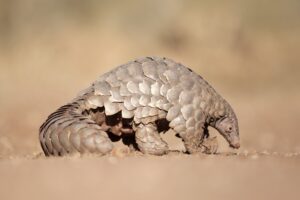A new wildlife documentary is heading to Netflix soon. Releasing on 21 April 2025 from the director of ‘My Octopus Teacher’, Pippa Ehrlich, ‘Pangolin: Kulu’s Journey‘ is the story of a rehabilitated South African pangolin, Kulu, who was caught up in a sting operation. This documentary was created with the hope that more attention will be paid to the conservation of the most trafficked animal in the world.
Pangolins, or scaly anteaters, have the title as the most trafficked species in the world, with over a million of them taken from the wild in the past decade. Despite international efforts to curb their illegal trade, the demand for their scales and meat, used in traditional medicine and as a delicacy in some Asian countries, continues to fuel this devastating trade.
With all eight species listed as vulnerable, endangered, or critically endangered by the International Union for Conservation of Nature (IUCN), there is an urgent need to protect and conserve these unique creatures.

The Threats Facing Pangolins
Pangolins are heavily poached and trafficked due to the high demand for their scales and meat. The scales are believed to have medicinal properties in some traditional medicine systems, while their meat is considered a delicacy in some parts of Asia.
The four African species, the giant ground pangolin, the white-bellied pangolin, the black-bellied pangolin, and the Temminck’s ground pangolin, are particularly at risk due to this illegal trade.
Seeing a pangolin in the wild is a rare and special experience, as they are nocturnal, shy, and well-camouflaged. However, joining a conservation project or a specialised safari that focuses on pangolins offers a better chance of spotting them and contributing to their conservation.
Pangolin Hotline to Fight Against Trafficking
A hotline has been launched in an effort to combat trafficking and preserve pangolins in Africa. The Pangolert number is +27 72 726 4654 and was created by Pangoli.Africa, a non-profit organisation, for real-time reporting of pangolin sightings and trafficking incidents. This number is contactable 24/7 via phone call and WhatsApp to link callers to a vetted network of veterinarians, non-governmental organisations, and law enforcement agencies across central and southern Africa.
The data collected by Pangolert also contributes to conservation research, which helps conservationists monitor pangolin population trends and inform protection strategies.
“Our goal is to support African conservation efforts by collecting population data based on sightings from anyone who comes in contact with a pangolin, be that a ranger, a safari tourist, law enforcement or conservation researcher,” Pangolin.Africa Founder, Toby Jermyn, explains.
Pangolin Conservation Projects in Africa
Luckily, there are organisations doing incredible work in the world of pangolin conservation.
Pangolin Conservation and Research Foundation (PCRF)
This non-profit organisation operates in southern Africa, working to ensure a sustainable future for pangolins through conservation, research, collaboration, education, and community engagement. Their projects include monitoring, rescuing, rehabilitating, and releasing pangolins back into the wild. They also offer volunteer opportunities and educational programmes for those interested in supporting their work.
The Pangolin Project
The Pangolin Project‘s goal is to protect the last remaining giant pangolins in Kenya. Their work centres on the Nyekweri Forest, the last stronghold of these animals in the country. Over 4,000 acres of the forest have been saved from human impact, and through donations, they hope to acquire long-term conservation leases and begin forest restoration.
Best Places to See Pangolins in Africa
Tswalu Kalahari Reserve
As a luxury private reserve in South Africa, Tswalu Kalahari Reserve is home to the largest population of free-roaming Temminck’s ground pangolins in the country. Their dedicated Pangolin Project conducts research on the ecology and behaviour of these animals. Guests can join researchers on night drives to track and observe pangolins in their natural habitat.
Okonjima Nature Reserve
A luxury private reserve in Namibia, Okonjima Nature Reserve is known for its cheetah and leopard conservation projects. However, their Pangolin Research Project focuses on the population dynamics, home range, diet, and threats to the Temminck’s ground pangolins in the area. They also rescue and rehabilitate injured or confiscated pangolins for release back into the wild. Guests can join night drives to see these elusive creatures.
Ol Pejeta Conservancy
A wildlife sanctuary in Kenya, Ol Pejeta Conservancy hosts the largest black rhino population in East Africa and a Pangolin Project that works to protect and monitor the giant ground pangolins and tree pangolins living there. They use camera traps, radio collars, and field surveys to collect data on distribution, abundance, activity patterns, and threats. They also rescue and rehabilitate injured or orphaned pangolins for release back into the wild.
The pangolin’s plight is a stark reminder of the devastating impacts of illegal wildlife trafficking. By supporting conservation projects, visiting reserves that prioritise pangolin protection, and raising awareness about these unique creatures, we can contribute to their survival and ensure their presence in the African wilderness for future generations.
Author: Devryn Panaino
Published:
Last Update: